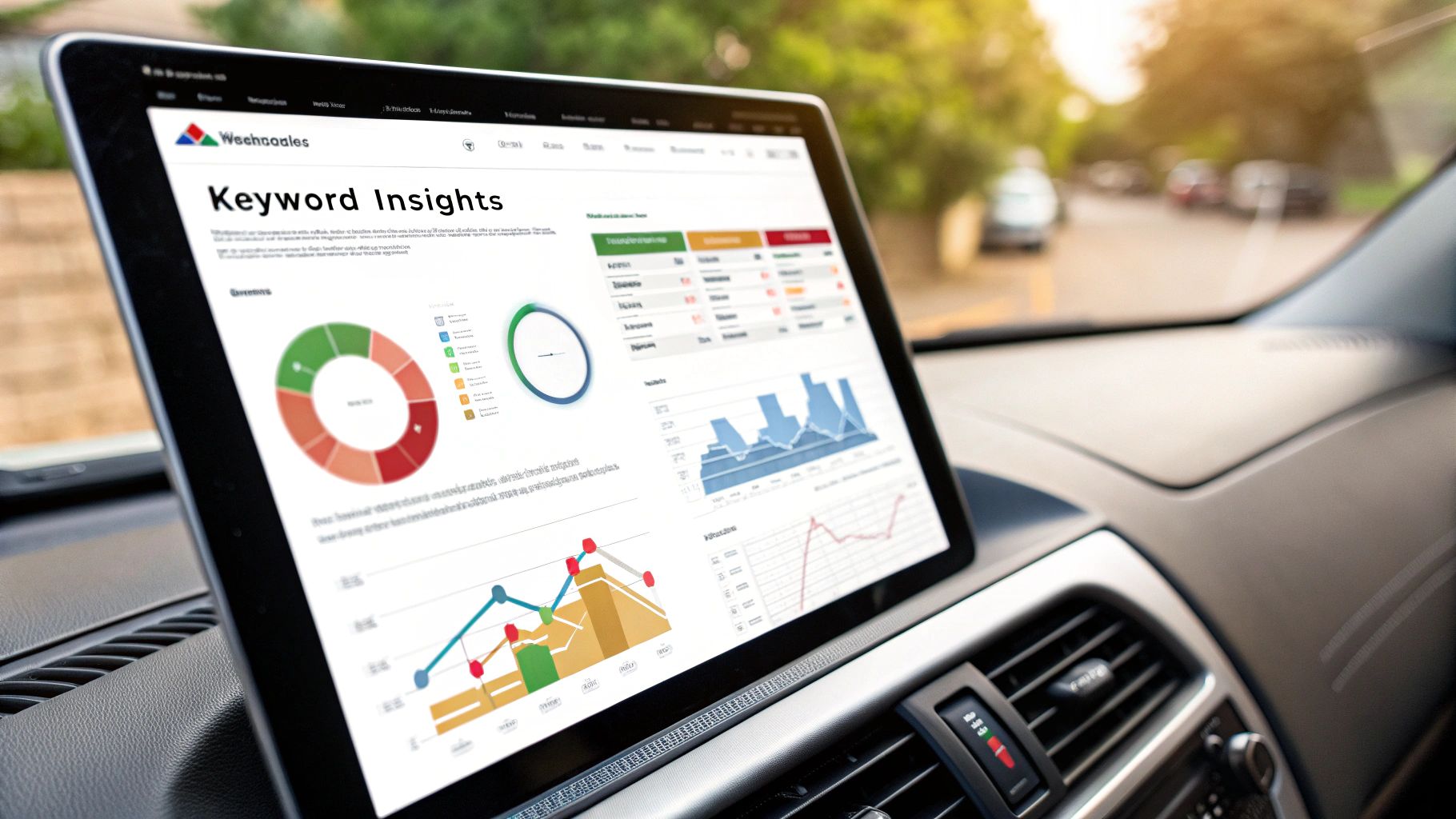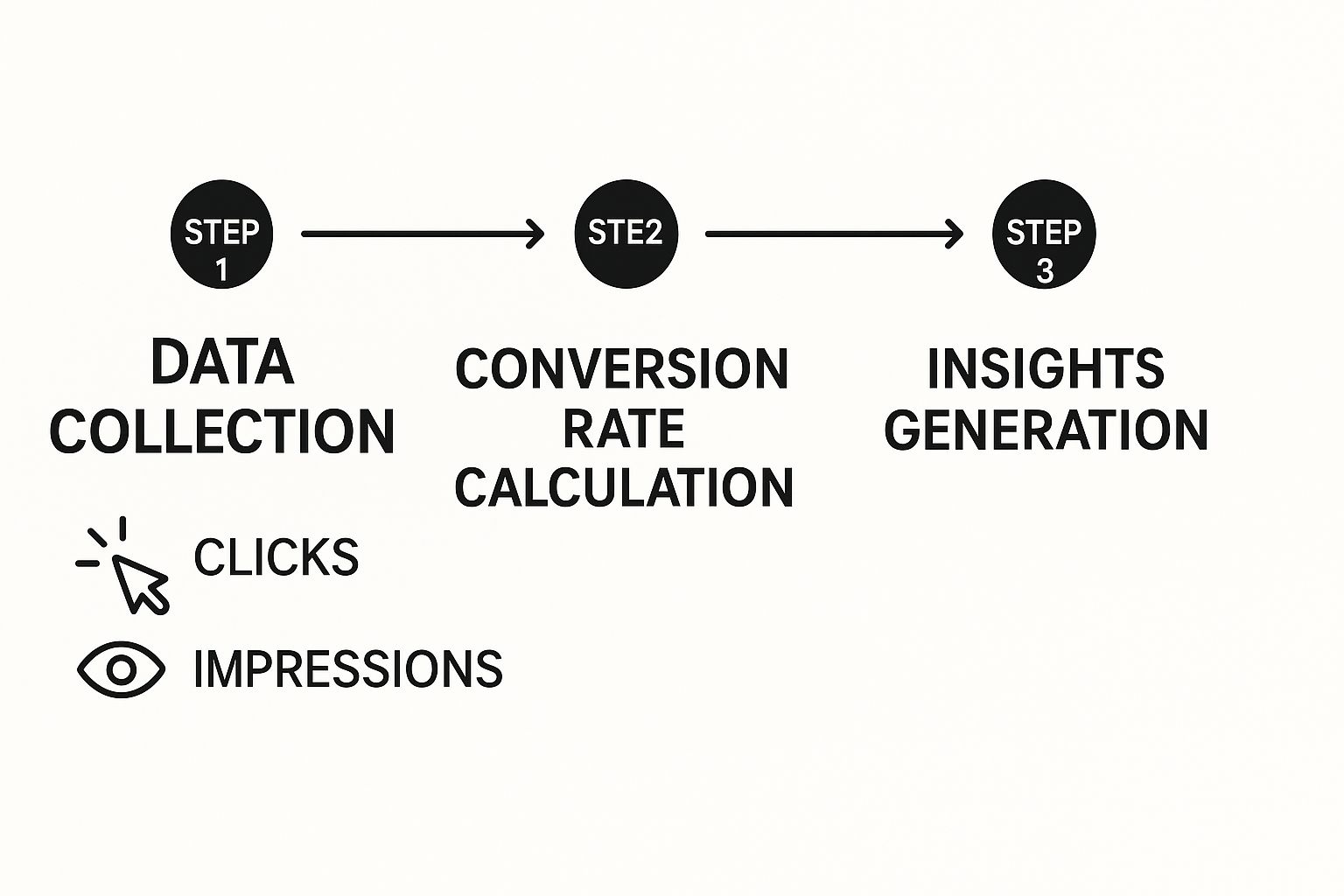July 16, 2025
Paid Search Analysis to Boost Your PPC Performance


Let's get one thing straight: paid search analysis isn't about popping into your Google Ads dashboard for a quick peek. It's about playing detective with your ad spend. You're digging deep into campaign data to figure out what’s working, what's a complete waste of money, and—most importantly—why.
Real analysis goes way beyond vanity metrics like clicks and impressions. It's about finding those actionable nuggets of information that can seriously crank up your ROI. It’s the difference between blindly spending money and strategically investing it.
What Is Paid Search Analysis, Really?
At its heart, paid search analysis is all about methodically sifting through your advertising data to make your campaigns better. It’s not just reporting on clicks and impressions; it’s about understanding the story those numbers are trying to tell you. This whole process is designed to help you make smart, strategic decisions instead of just throwing things at the wall to see what sticks.
The goal isn't just to see what happened last week. It's to understand why it happened and figure out how to get even better results next time. Whether you run your campaigns in-house or lean on professional PPC services, getting a solid grip on analysis is non-negotiable.
It's More Than Just a Numbers Game
Platforms like Google Ads can feel like you're drinking from a firehose of data. Good analysis is your filter, helping you separate the noise from the valuable insights.
This is the logo for Google Ads, which is where you'll be spending most of your time turning raw data into strategic campaign improvements.

Thinking analytically helps you connect dots that aren't immediately obvious. For instance, a high click-through rate (CTR) looks fantastic on the surface. But if none of those clicks are turning into actual sales, you're basically just paying for window shoppers.
Proper paid search analysis is the difference between spending money and investing money. It turns your ad budget from a blind expense into a predictable engine for business growth.
Why Smart Analysis Matters More Than Ever
The world of search advertising is only getting more crowded and competitive. The market is projected to hit a mind-boggling US$351.55 billion by 2025. That number alone shows just how crucial it is to make every single dollar count.
And people are paying attention. A solid 75% of users say that paid search ads actually make it easier for them to find what they're looking for online. This proves that when done right, your ads are a welcome part of the user's journey.
To break it down, here’s a quick look at the core components of a paid search analysis.
Core Components of Paid Search Analysis
Ultimately, a solid analysis framework helps you nail the fundamentals and stay ahead of the curve.
Your Strategic Advantage
When you have a strong analysis process in place, you can:
- Pinpoint Wasted Spend: Quickly spot and pause the keywords or ad groups that are just burning cash without bringing in results.
- Discover Growth Opportunities: Uncover those high-performing keywords, audiences, or even times of day that you can double down on.
- Boost Conversion Rates: Optimize your ads and landing pages based on what the data proves your audience responds to.
- Improve Overall ROI: Make data-driven decisions that directly impact your bottom line. It’s as simple as that.
Laying the Groundwork for Your Analysis
Jumping into a mountain of paid search data without a clear plan is a recipe for disaster. It’s a lot like trying to build a house without a blueprint—you’ll be busy, sure, but the end result will be a chaotic mess. Before you can pull any real insights from your campaigns, you have to lay a solid foundation. This initial setup is what makes sure the data you collect is accurate, relevant, and actually tied to your business goals.
It all boils down to picking the right Key Performance Indicators (KPIs). It's incredibly easy to get sidetracked by flashy numbers like impressions or clicks, but honestly, those are often just vanity metrics. Your KPIs need to be the numbers that tell you whether you're making money. Think Cost Per Acquisition (CPA), Return On Ad Spend (ROAS), or Conversion Rate.
The goal is simple: choose metrics that directly reflect your business objectives. If you're trying to sell widgets, you don't care how many people saw your ad; you care how much it cost to sell one widget.
Once you know what you’re measuring, you need the right tools in your toolkit. For most of us in the paid search world, this means getting intimately familiar with the platforms where our data lives.
- Google Ads & Microsoft Ads: These are your command centers. They hold all the raw data on your campaigns, from clicks and costs to which ad copy is actually working.
- Google Analytics: This is where you see what happens after the click. It gives you the full story on user behavior, showing you how the traffic you paid for is interacting with your site.
To get an even bigger picture of your digital performance, it helps to see how your paid efforts fit in with everything else. For instance, understanding your organic search performance can provide valuable context. You can get a more complete view of your digital footprint by exploring options for foundational SEO analytics with Rank Math. This helps you connect the dots between paid and organic.
Getting Your Data Ducks in a Row
With your goals and tools sorted, the next step is making sure your data is actually reliable. This all comes down to one critical thing: accurate conversion tracking. If your tracking is off, every analysis you run will be built on shaky ground. Seriously, double and triple-check that your conversion actions—whether it's a form submission, a product purchase, or a phone call—are firing correctly.
This setup is non-negotiable, especially when you think about the sheer scale of the market. Globally, people conduct around 7 billion searches every single day. In the U.S. alone, search ad spending is projected to reach $124.59 billion in 2024, with Google commanding a massive 50.5% of the market. With that much activity and money at stake, you simply can't afford to make decisions based on bad data. You can dig into more of these massive search advertising statistics on llcbuddy.com.
Creating Dashboards for At-a-Glance Insights
Finally, don't let your valuable data get buried in complex platform reports. The best analysts I know build custom dashboards to see their most important KPIs at a glance.
A good dashboard should immediately answer your most important questions:
- Are we hitting our ROAS or CPA targets?
- Which campaigns are actually driving conversions?
- Are there any sudden performance drops I need to investigate?
Tools like Google Looker Studio (what we used to call Data Studio) or even the dashboards built into Google Ads let you create a single, central view of your performance. This saves you from the tedious work of pulling reports and frees you up to focus on what really matters: making smart, strategic optimizations. This foundation is what makes every other step of your paid search analysis possible.
How to Analyze Campaign and Ad Group Performance
Alright, now we get to the good stuff. With your tracking and KPIs sorted, it's time to actually dig into your campaigns and ad groups to see what's working and what's not. This is how you find which campaigns deserve more budget and which ones are just burning cash.

We have to move past looking at metrics in a vacuum. A 5% Click-Through Rate (CTR) seems impressive, but it's useless if it's not leading to a single conversion. Similarly, a low Cost-Per-Click (CPC) feels like a victory, but not if you're paying for completely irrelevant traffic. Context is key.
Looking Beyond Surface-Level Metrics
Any real paid search analysis starts by connecting the dots between your core metrics. It's like a mechanic diagnosing an engine problem—they don’t just look at one gauge; they listen to the engine, check the fluids, and hook it up to a diagnostic tool to understand the full picture.
Let's say you're looking at a campaign with a fantastic CTR but a dismal conversion rate. Don't just pause it! This is a valuable clue. It tells you your ad is compelling and your keywords are likely relevant, but something is breaking down on the landing page. The disconnect could be anything from mismatched messaging to a confusing user experience.
Now, flip that scenario. What if your CTR is terrible, but the handful of clicks you do get convert like crazy? This is a great problem to have. It suggests your offer and landing page are perfectly aligned with a core audience, but your ad copy or keyword targeting isn't broad or punchy enough to capture attention. You've found a pocket of high intent; now you just need to expand it.
A high Cost-Per-Acquisition (CPA) is never just one problem; it's a symptom. Your job is to play detective and figure out if the cause is expensive clicks (a bidding or quality score issue) or a poor conversion rate (a landing page or offer issue).
Segmenting Your Data for Deeper Insights
To get to the root cause of performance issues, you have to slice your data into meaningful segments. Relying on account-level averages is the fastest way to miss your biggest opportunities.
Start by breaking down your campaign performance by these critical dimensions:
- Device: Are your desktop users converting, while mobile users just browse and bounce? You might have a mobile user experience issue or need to implement a negative mobile bid adjustment.
- Network: Compare how you're doing on the Google Search Network versus the Search Partners. I've often found that Search Partners can bring in cheaper clicks, but the quality can be spotty. If the traffic isn't converting, don't hesitate to opt out.
- Time of Day/Day of Week: Do you see performance surge on weekday mornings or late on Sunday nights? Use ad scheduling to push your bids up during peak conversion times and pull back when your audience is less active.
For example, I once managed an account for a B2B software company and saw that nearly all their valuable leads came from desktop users between 9 a.m. and 4 p.m. on weekdays. In contrast, evening and weekend traffic was mostly just curious browsers. By layering device and time-of-day bid adjustments, we focused their budget where it mattered most and cut wasted spend significantly.
This granular approach moves you from simple reporting to making precise, impactful changes. For more advanced techniques, our complete guide on PPC campaign optimization goes into even greater detail. It's this level of analysis that uncovers the hidden gems your competitors are probably overlooking.
Uncovering Gold in Your Keywords and Search Queries
If your campaigns and ad groups are the engine, then your keywords are the high-octane fuel that makes everything run. But let’s be real, not all fuel is created equal. True paid search analysis goes way beyond just pausing the expensive keywords that aren’t converting. It means getting your hands dirty in the Search Query Report—what I like to call the treasure map of PPC.
This is where you see what people actually typed into Google before clicking your ad. It’s a goldmine. This report is where you'll find those small, high-impact tweaks that can turn a good campaign into a truly great one. You'll dig up new, high-intent keywords to add and, just as important, spot the irrelevant junk that's quietly bleeding your budget dry every single day.
How to Mine Your Search Query Report
I always tell people to think of their keyword list as the net they cast. The search query report? That’s everything you caught. Sometimes you get exactly what you were hoping for, but other times you pull up old boots and seaweed. Your job is to sort through it all, keep the good stuff, and get rid of the junk.
The process is straightforward: pinpoint queries that scream "I'm ready to buy!" and add them as exact or phrase match keywords. On the flip side, you have to be ruthless about finding and excluding irrelevant searches. Building a solid list of Google Ads negative keywords is one of the fastest ways I've seen to improve an account’s health and stop wasting money. It’s non-negotiable.
Here’s a simple workflow I use for my own clients that breaks this down into actionable steps. It helps turn what can feel like an overwhelming data dump into a clear, repeatable process.
A Practical Search Query Analysis Workflow
Following these steps regularly—say, once a week—keeps your campaigns clean and efficient. You'll be amazed at how quickly you can improve performance by just staying on top of what people are actually searching for.
Going Beyond Match Types and Cannibalization
A deeper dive means looking at how your match types are performing. Are your broad match keywords bringing in creative new queries, or are they just a magnet for irrelevant clicks? Maybe your exact match keywords have a stellar conversion rate but almost no impression volume. What does that tell you?
The goal here is to use different match types for different strategic purposes. Broad match for discovery, phrase match for a balance of control and reach, and exact match for pure precision and efficiency.
You also need to watch out for keyword cannibalization. This sneaky problem happens when multiple ad groups are triggered by the same search query. When that occurs, you’re literally competing against yourself, which drives up your costs and completely muddies your performance data. Make it a habit to check which ad group is showing for your most important search terms. You need to ensure the most relevant ad is always the one that gets served.
This whole process is about turning raw data into actionable insights that make a real difference.

As you can see, you start with the basic data, calculate your core metrics, and then—this is the important part—you generate insights that lead to smart campaign improvements.
Using Impression Share for a Competitive Edge
Finally, don’t sleep on your impression share metrics. These numbers tell you how often your ads are showing up compared to how often they could be showing up. It’s your competitive pulse.
Here’s what I look for:
- Lost IS (Budget): If this number is high, your budget is tapping out before the day is over on your best campaigns. It's a flashing neon sign telling you to increase your daily spend if the campaign is profitable.
- Lost IS (Rank): A high number here means your Ad Rank (a combination of your bid and Quality Score) is too low to compete effectively. To fix this, you either need to bid more aggressively or get to work on improving your ad relevance and landing page experience.
Analyzing impression share shows you exactly where you stand against the competition. More importantly, it highlights the most direct path to capturing more qualified traffic. It’s this granular level of keyword and query analysis that turns your PPC campaigns into a finely-tuned, efficient machine.
Turning Your Insights Into Actionable Optimizations
That "aha!" moment during your paid search analysis? It’s a great feeling. But let's be real—an insight is completely useless until you actually do something with it. This is where the magic happens, turning all that data-diving into real campaign improvements that move the needle.

So, where do you even begin? Your analysis might flag a bunch of different problems: weak ad copy, a terrible CPA in one campaign, and wasted spend in another. It's easy to get analysis paralysis. The trick is to prioritize based on impact.
Deciding What to Fix First
Okay, so what gets your attention first? The ad copy, the bids, or that landing page that needs a total makeover? I've found a simple framework helps cut through the noise.
Stop the Bleeding: First things first, tackle anything that's just hemorrhaging cash. Nine times out of ten, this means going straight back to your search query report and beefing up your negative keyword list. If you're paying for clicks that have zero shot at converting, that's leak #1 to plug. Pronto.
Go for the Big Wins: Next, look for the changes that will create the biggest splash. If a single campaign is eating 60% of your budget but has a dismal conversion rate, focusing your energy there will have a much bigger payoff than fiddling with a tiny, low-traffic ad group.
Test and Refine: Finally, you can start chipping away at the smaller opportunities with A/B testing. This is your chance to experiment with new headlines, different calls-to-action, or smarter bid strategies to really squeeze every last drop of performance out of your campaigns.
For a deeper look at putting these ideas into practice, this guide to Google Ads campaign optimization is a great resource that breaks these concepts down even further.
Building a Continuous Feedback Loop
Ultimately, paid search analysis isn't about a one-and-done fix. It’s about creating a constant feedback loop. Analysis leads to an optimization, that optimization generates fresh data, and that new data kicks off your next round of analysis. It’s a cycle of perpetual, measurable improvement.
Your paid search account should be a living, breathing thing. The data it produces is its way of telling you what it needs to grow stronger—you just have to listen and act.
To put your performance in context, it really helps to know the industry benchmarks. For instance, knowing the average Google Ads CPC is around $2.69 helps you see if your own costs are reasonable or way off base.
Same goes for other metrics. With an average CTR of 3.17% and a conversion rate hovering near 2.55%, you can get a better sense of whether your campaigns are actually pulling their weight. Even knowing that paid search bounce rates average about 43.9% gives you a solid baseline for judging your landing page performance.
This cycle of analysis and action is what truly separates the good account managers from the great ones.
Got Questions About Paid Search Analysis?
Even after laying it all out, a few questions always pop up. That’s perfectly fine—getting into the weeds of paid search analysis brings up some common head-scratchers. Let’s tackle some of the most frequent ones I hear.
How Often Should I Really Be Analyzing My Campaigns?
This is a classic question, and the honest answer is: it depends on your account's size and how much you're spending. There’s no magic number, but you should definitely find a rhythm that works for you.
If you're managing a larger account with a hefty budget, a quick daily check-in is just smart. Think of it as a 5-minute coffee check. You're not doing a deep dive; you're just making sure the wheels haven't fallen off overnight.
The real meat of your analysis should happen weekly. This is when you set aside some solid time to really dig in.
- Hit the Search Query Report: This is non-negotiable. You’ve got to see where your money is actually going and sniff out new opportunities or wasteful clicks.
- Check your ad performance: Which ads are resonating with people? Which ones are falling flat?
- Segment your data: How are things looking on mobile vs. desktop? What about different times of day or specific audiences?
Save the big-picture thinking for your monthly and quarterly reviews. That's when you zoom out, look for major trends, see how you’re tracking against your goals, and plan your next big strategic moves. The goal is to make analysis a regular habit, not a panicked reaction when things go south.
What's the Real Difference Between Clicks and Impressions?
This one feels basic, but it trips up so many people. Nailing this concept is fundamental to reading your performance data correctly.
An impression is simple: your ad showed up. Someone, somewhere, saw it on a search results page. A click is when that person actually took action—they were intrigued enough to click your ad and land on your site.
Think of it this way: impressions are your potential, your visibility. Clicks are the proof that your message is connecting. The relationship between them, your Click-Through Rate (CTR), tells you how compelling your ad is. They're two different sides of the same performance coin.
My CPA Is Skyrocketing! Where Do I Look First?
A high Cost Per Acquisition (CPA) is probably the most common fire drill in the PPC world. When you see that number climbing, don't panic. There's a go-to checklist.
First thing's first: open your Search Query Report. Nine times out of ten, this is where the problem lives. Are you paying for junk clicks that have nothing to do with your business? Start adding those terms as negative keywords immediately. After that, look at your actual keywords and pause any that are burning cash without bringing in conversions.
Next, look at the journey from ad to landing page. Does your ad promise something your page doesn't deliver? That disconnect will kill your conversion rate and send your CPA through the roof. Finally, review your bidding strategy. Are you simply bidding too aggressively and paying a premium for traffic that isn’t converting? It happens more often than you'd think.
Ready to stop wasting time and money on ineffective keywords? keywordme turns painful search query reports into actionable insights in just one click. Our powerful tool automates negative keyword discovery and helps you find high-converting keywords, cutting down your optimization time and boosting your ROI. Start your free trial today and see the difference at https://www.keywordme.io.


.svg)